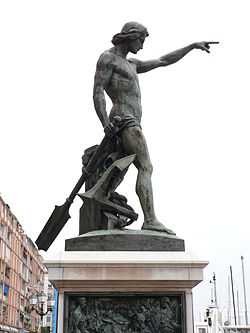Louis-Joseph Daumas
From Wikipedia, the free encyclopedia

Genius of Navigation, Toulon
Louis-Joseph Daumas (1801-1887) was a French sculptor and medallist.
Born in Toulon, Daumas was admitted into the École nationale supérieure des Beaux-Arts in 1826,[1] and entered the atelier of David d'Angers.[2]
Daumas's work includes:
- Genius of Navigation, bronze statue of French Admiral Jules de Cuverville with four bas-reliefs on the base, port of Toulon, 1847, reconstructed after its destruction in World War II
- exterior statue of François Eudes de Mézeray, Cour Napoléon in the Louvre, Paris, prior to 1853
- Roman cavalier and his horse, on the right bank of the Pont d'Iéna (Jura Bridge), Paris, 1853
- equestrian sculpture of José de San Martín in the Plaza San Martín of Buenos Aires, 1862, with copies at the Parque del Oeste in Madrid, and Central Park in New York City
- equestrian sculpture at the Sakıp Sabancı Museum, Istanbul, 1864
References
- ↑ http://www.wikiphidias.fr/index.php?option=com_content&view=article&id=94:daumas-louis-joseph&catid=34:biographie&Itemid=53
- ↑ American architect and architecture, Volumes 33-34, No. 813, page 56
| Wikimedia Commons has media related to Louis-Joseph Daumas. |
This article is issued from Wikipedia. The text is available under the Creative Commons Attribution/Share Alike; additional terms may apply for the media files.